Greenhouse Gas Emissions Analysis in Water Production and Treatment
VerifiedAdded on 2023/06/11
|8
|2155
|432
Report
AI Summary
This report delves into the critical issue of greenhouse gas (GHG) emissions in water production, emphasizing the gases' impact on atmospheric thermal heating and climate change. It identifies key contributors such as fossil fuel combustion and explores methods for calculating GHG emissions, particularly within water treatment processes. The analysis covers aspects like energy losses, sludge management, and chemical usage, highlighting the interconnectedness of water utility management and GHG emissions. Effective water utility management practices are discussed, advocating for optimized water utilization through mineral energy and sustainable energy management systems. The report concludes by stressing the importance of assessing GHG effects throughout the entire water production process, from pretreatment to discharge, to mitigate climate change impacts. Desklib provides students with access to this document and numerous other solved assignments and resources.
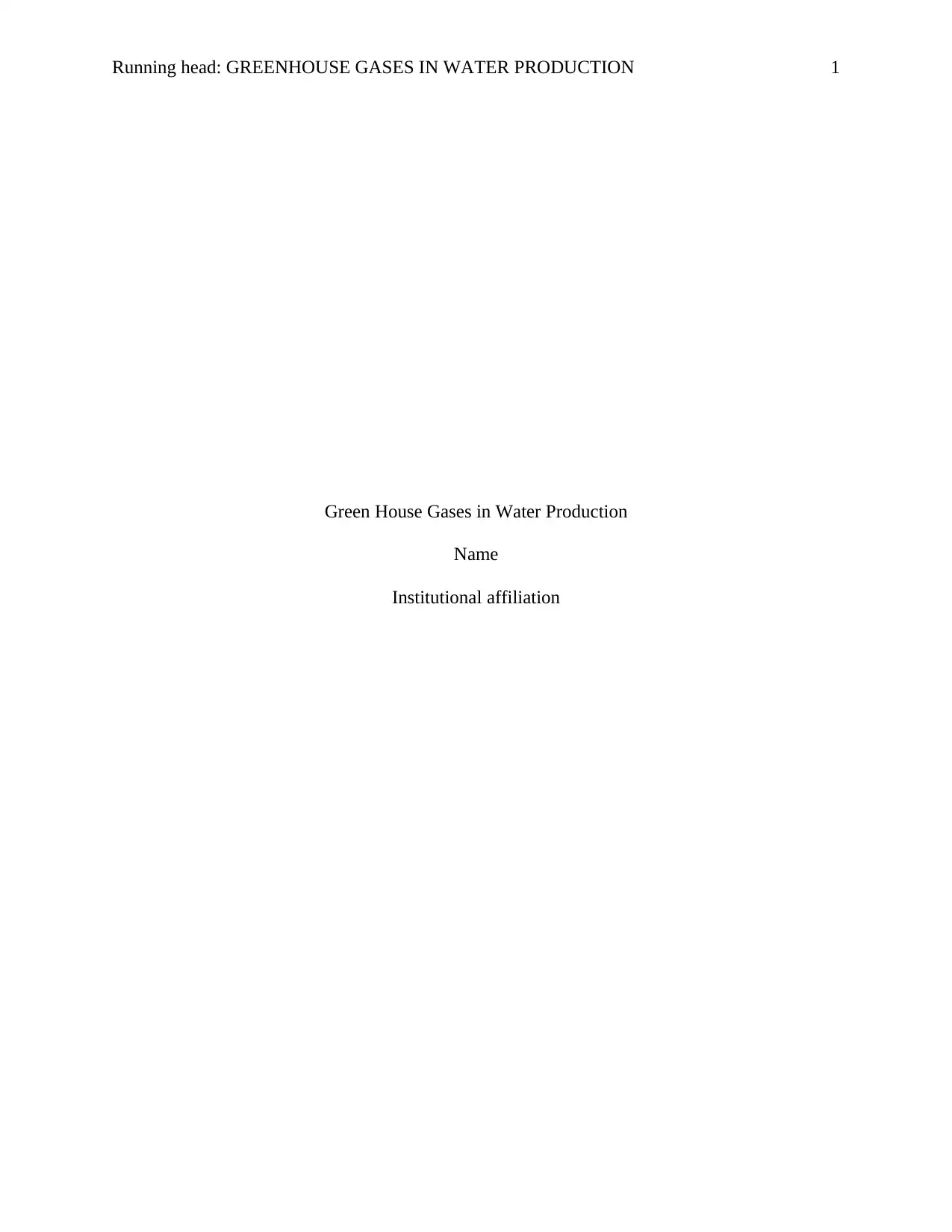
Running head: GREENHOUSE GASES IN WATER PRODUCTION 1
Green House Gases in Water Production
Name
Institutional affiliation
Green House Gases in Water Production
Name
Institutional affiliation
Paraphrase This Document
Need a fresh take? Get an instant paraphrase of this document with our AI Paraphraser
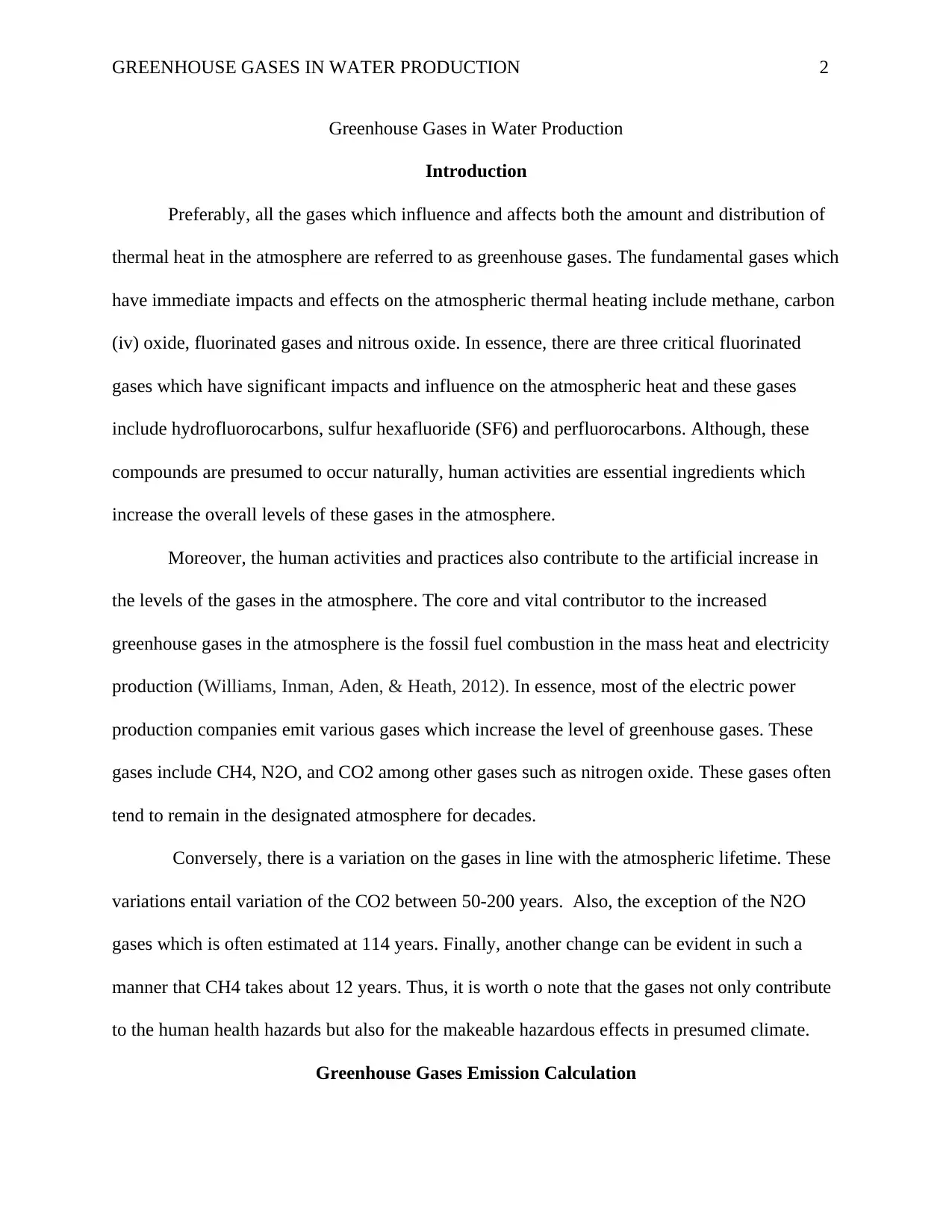
GREENHOUSE GASES IN WATER PRODUCTION 2
Greenhouse Gases in Water Production
Introduction
Preferably, all the gases which influence and affects both the amount and distribution of
thermal heat in the atmosphere are referred to as greenhouse gases. The fundamental gases which
have immediate impacts and effects on the atmospheric thermal heating include methane, carbon
(iv) oxide, fluorinated gases and nitrous oxide. In essence, there are three critical fluorinated
gases which have significant impacts and influence on the atmospheric heat and these gases
include hydrofluorocarbons, sulfur hexafluoride (SF6) and perfluorocarbons. Although, these
compounds are presumed to occur naturally, human activities are essential ingredients which
increase the overall levels of these gases in the atmosphere.
Moreover, the human activities and practices also contribute to the artificial increase in
the levels of the gases in the atmosphere. The core and vital contributor to the increased
greenhouse gases in the atmosphere is the fossil fuel combustion in the mass heat and electricity
production (Williams, Inman, Aden, & Heath, 2012). In essence, most of the electric power
production companies emit various gases which increase the level of greenhouse gases. These
gases include CH4, N2O, and CO2 among other gases such as nitrogen oxide. These gases often
tend to remain in the designated atmosphere for decades.
Conversely, there is a variation on the gases in line with the atmospheric lifetime. These
variations entail variation of the CO2 between 50-200 years. Also, the exception of the N2O
gases which is often estimated at 114 years. Finally, another change can be evident in such a
manner that CH4 takes about 12 years. Thus, it is worth o note that the gases not only contribute
to the human health hazards but also for the makeable hazardous effects in presumed climate.
Greenhouse Gases Emission Calculation
Greenhouse Gases in Water Production
Introduction
Preferably, all the gases which influence and affects both the amount and distribution of
thermal heat in the atmosphere are referred to as greenhouse gases. The fundamental gases which
have immediate impacts and effects on the atmospheric thermal heating include methane, carbon
(iv) oxide, fluorinated gases and nitrous oxide. In essence, there are three critical fluorinated
gases which have significant impacts and influence on the atmospheric heat and these gases
include hydrofluorocarbons, sulfur hexafluoride (SF6) and perfluorocarbons. Although, these
compounds are presumed to occur naturally, human activities are essential ingredients which
increase the overall levels of these gases in the atmosphere.
Moreover, the human activities and practices also contribute to the artificial increase in
the levels of the gases in the atmosphere. The core and vital contributor to the increased
greenhouse gases in the atmosphere is the fossil fuel combustion in the mass heat and electricity
production (Williams, Inman, Aden, & Heath, 2012). In essence, most of the electric power
production companies emit various gases which increase the level of greenhouse gases. These
gases include CH4, N2O, and CO2 among other gases such as nitrogen oxide. These gases often
tend to remain in the designated atmosphere for decades.
Conversely, there is a variation on the gases in line with the atmospheric lifetime. These
variations entail variation of the CO2 between 50-200 years. Also, the exception of the N2O
gases which is often estimated at 114 years. Finally, another change can be evident in such a
manner that CH4 takes about 12 years. Thus, it is worth o note that the gases not only contribute
to the human health hazards but also for the makeable hazardous effects in presumed climate.
Greenhouse Gases Emission Calculation
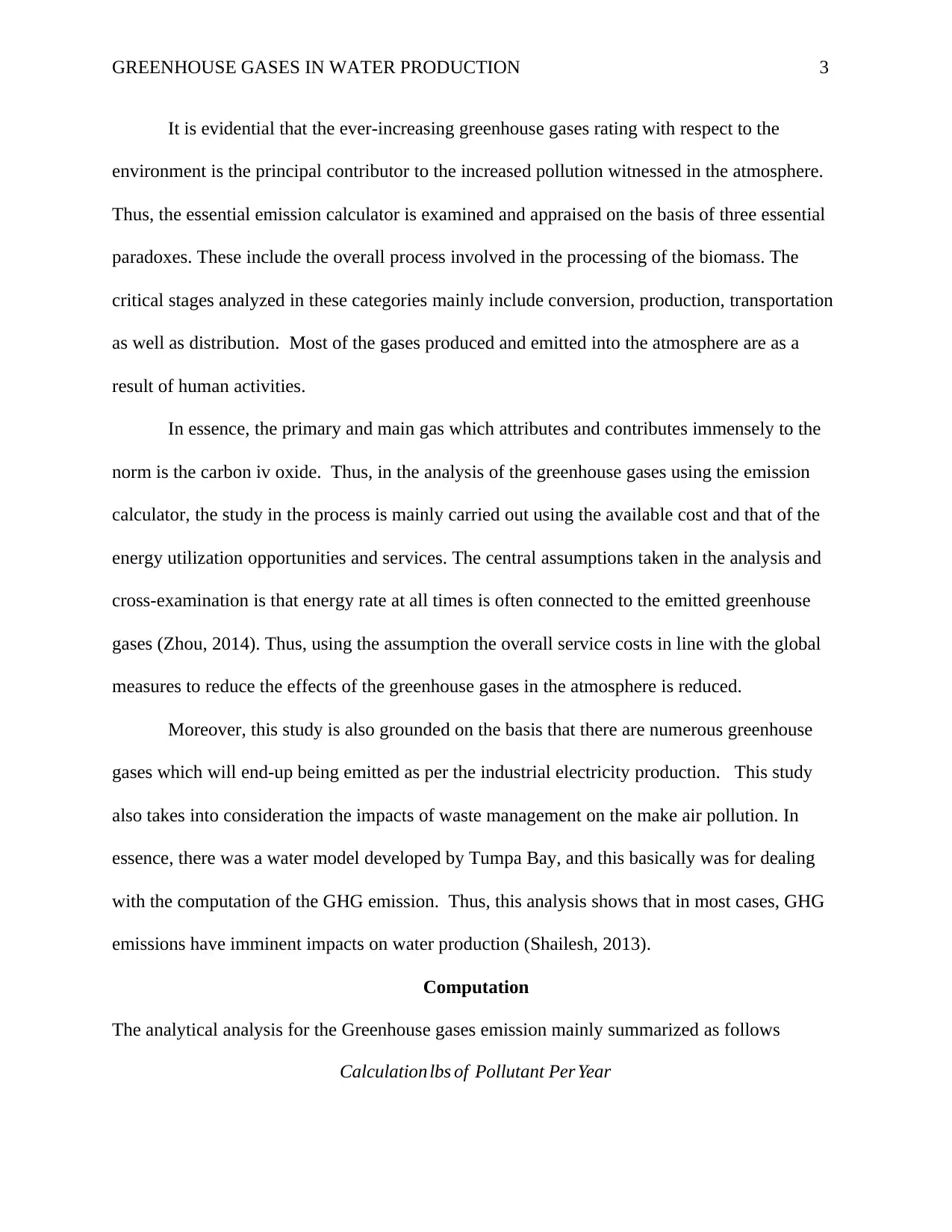
GREENHOUSE GASES IN WATER PRODUCTION 3
It is evidential that the ever-increasing greenhouse gases rating with respect to the
environment is the principal contributor to the increased pollution witnessed in the atmosphere.
Thus, the essential emission calculator is examined and appraised on the basis of three essential
paradoxes. These include the overall process involved in the processing of the biomass. The
critical stages analyzed in these categories mainly include conversion, production, transportation
as well as distribution. Most of the gases produced and emitted into the atmosphere are as a
result of human activities.
In essence, the primary and main gas which attributes and contributes immensely to the
norm is the carbon iv oxide. Thus, in the analysis of the greenhouse gases using the emission
calculator, the study in the process is mainly carried out using the available cost and that of the
energy utilization opportunities and services. The central assumptions taken in the analysis and
cross-examination is that energy rate at all times is often connected to the emitted greenhouse
gases (Zhou, 2014). Thus, using the assumption the overall service costs in line with the global
measures to reduce the effects of the greenhouse gases in the atmosphere is reduced.
Moreover, this study is also grounded on the basis that there are numerous greenhouse
gases which will end-up being emitted as per the industrial electricity production. This study
also takes into consideration the impacts of waste management on the make air pollution. In
essence, there was a water model developed by Tumpa Bay, and this basically was for dealing
with the computation of the GHG emission. Thus, this analysis shows that in most cases, GHG
emissions have imminent impacts on water production (Shailesh, 2013).
Computation
The analytical analysis for the Greenhouse gases emission mainly summarized as follows
Calculation lbs of Pollutant Per Year
It is evidential that the ever-increasing greenhouse gases rating with respect to the
environment is the principal contributor to the increased pollution witnessed in the atmosphere.
Thus, the essential emission calculator is examined and appraised on the basis of three essential
paradoxes. These include the overall process involved in the processing of the biomass. The
critical stages analyzed in these categories mainly include conversion, production, transportation
as well as distribution. Most of the gases produced and emitted into the atmosphere are as a
result of human activities.
In essence, the primary and main gas which attributes and contributes immensely to the
norm is the carbon iv oxide. Thus, in the analysis of the greenhouse gases using the emission
calculator, the study in the process is mainly carried out using the available cost and that of the
energy utilization opportunities and services. The central assumptions taken in the analysis and
cross-examination is that energy rate at all times is often connected to the emitted greenhouse
gases (Zhou, 2014). Thus, using the assumption the overall service costs in line with the global
measures to reduce the effects of the greenhouse gases in the atmosphere is reduced.
Moreover, this study is also grounded on the basis that there are numerous greenhouse
gases which will end-up being emitted as per the industrial electricity production. This study
also takes into consideration the impacts of waste management on the make air pollution. In
essence, there was a water model developed by Tumpa Bay, and this basically was for dealing
with the computation of the GHG emission. Thus, this analysis shows that in most cases, GHG
emissions have imminent impacts on water production (Shailesh, 2013).
Computation
The analytical analysis for the Greenhouse gases emission mainly summarized as follows
Calculation lbs of Pollutant Per Year
⊘ This is a preview!⊘
Do you want full access?
Subscribe today to unlock all pages.

Trusted by 1+ million students worldwide
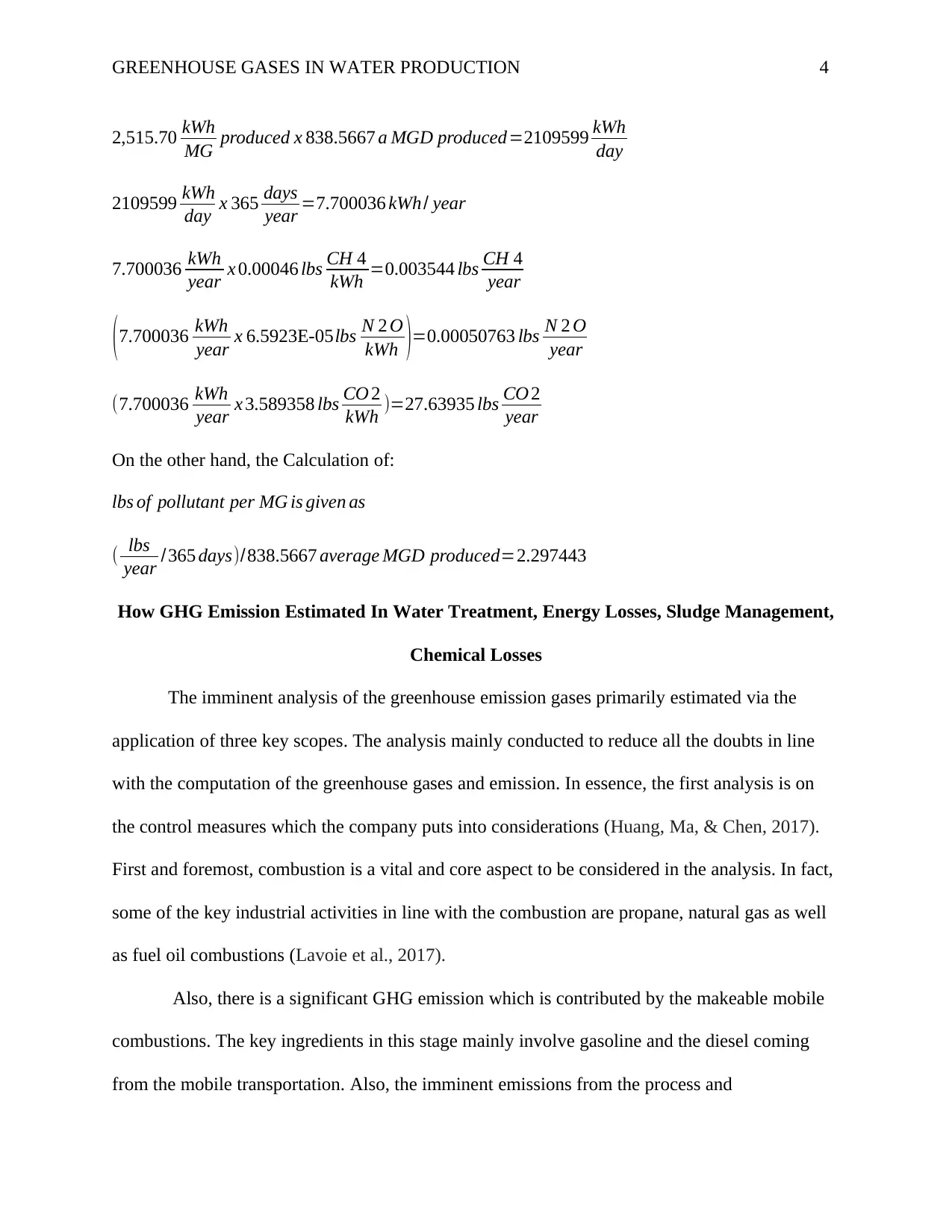
GREENHOUSE GASES IN WATER PRODUCTION 4
2,515.70 kWh
MG produced x 838.5667 a MGD produced=2109599 kWh
day
2109599 kWh
day x 365 days
year =7.700036 kWh/ year
7.700036 kWh
year x 0.00046 lbs CH 4
kWh =0.003544 lbs CH 4
year
(7.700036 kWh
year x 6.5923E-05lbs N 2 O
kWh )=0.00050763 lbs N 2 O
year
(7.700036 kWh
year x 3.589358 lbs CO 2
kWh )=27.63935 lbs CO 2
year
On the other hand, the Calculation of:
lbs of pollutant per MG is given as
( lbs
year /365 days)/838.5667 average MGD produced=2.297443
How GHG Emission Estimated In Water Treatment, Energy Losses, Sludge Management,
Chemical Losses
The imminent analysis of the greenhouse emission gases primarily estimated via the
application of three key scopes. The analysis mainly conducted to reduce all the doubts in line
with the computation of the greenhouse gases and emission. In essence, the first analysis is on
the control measures which the company puts into considerations (Huang, Ma, & Chen, 2017).
First and foremost, combustion is a vital and core aspect to be considered in the analysis. In fact,
some of the key industrial activities in line with the combustion are propane, natural gas as well
as fuel oil combustions (Lavoie et al., 2017).
Also, there is a significant GHG emission which is contributed by the makeable mobile
combustions. The key ingredients in this stage mainly involve gasoline and the diesel coming
from the mobile transportation. Also, the imminent emissions from the process and
2,515.70 kWh
MG produced x 838.5667 a MGD produced=2109599 kWh
day
2109599 kWh
day x 365 days
year =7.700036 kWh/ year
7.700036 kWh
year x 0.00046 lbs CH 4
kWh =0.003544 lbs CH 4
year
(7.700036 kWh
year x 6.5923E-05lbs N 2 O
kWh )=0.00050763 lbs N 2 O
year
(7.700036 kWh
year x 3.589358 lbs CO 2
kWh )=27.63935 lbs CO 2
year
On the other hand, the Calculation of:
lbs of pollutant per MG is given as
( lbs
year /365 days)/838.5667 average MGD produced=2.297443
How GHG Emission Estimated In Water Treatment, Energy Losses, Sludge Management,
Chemical Losses
The imminent analysis of the greenhouse emission gases primarily estimated via the
application of three key scopes. The analysis mainly conducted to reduce all the doubts in line
with the computation of the greenhouse gases and emission. In essence, the first analysis is on
the control measures which the company puts into considerations (Huang, Ma, & Chen, 2017).
First and foremost, combustion is a vital and core aspect to be considered in the analysis. In fact,
some of the key industrial activities in line with the combustion are propane, natural gas as well
as fuel oil combustions (Lavoie et al., 2017).
Also, there is a significant GHG emission which is contributed by the makeable mobile
combustions. The key ingredients in this stage mainly involve gasoline and the diesel coming
from the mobile transportation. Also, the imminent emissions from the process and
Paraphrase This Document
Need a fresh take? Get an instant paraphrase of this document with our AI Paraphraser
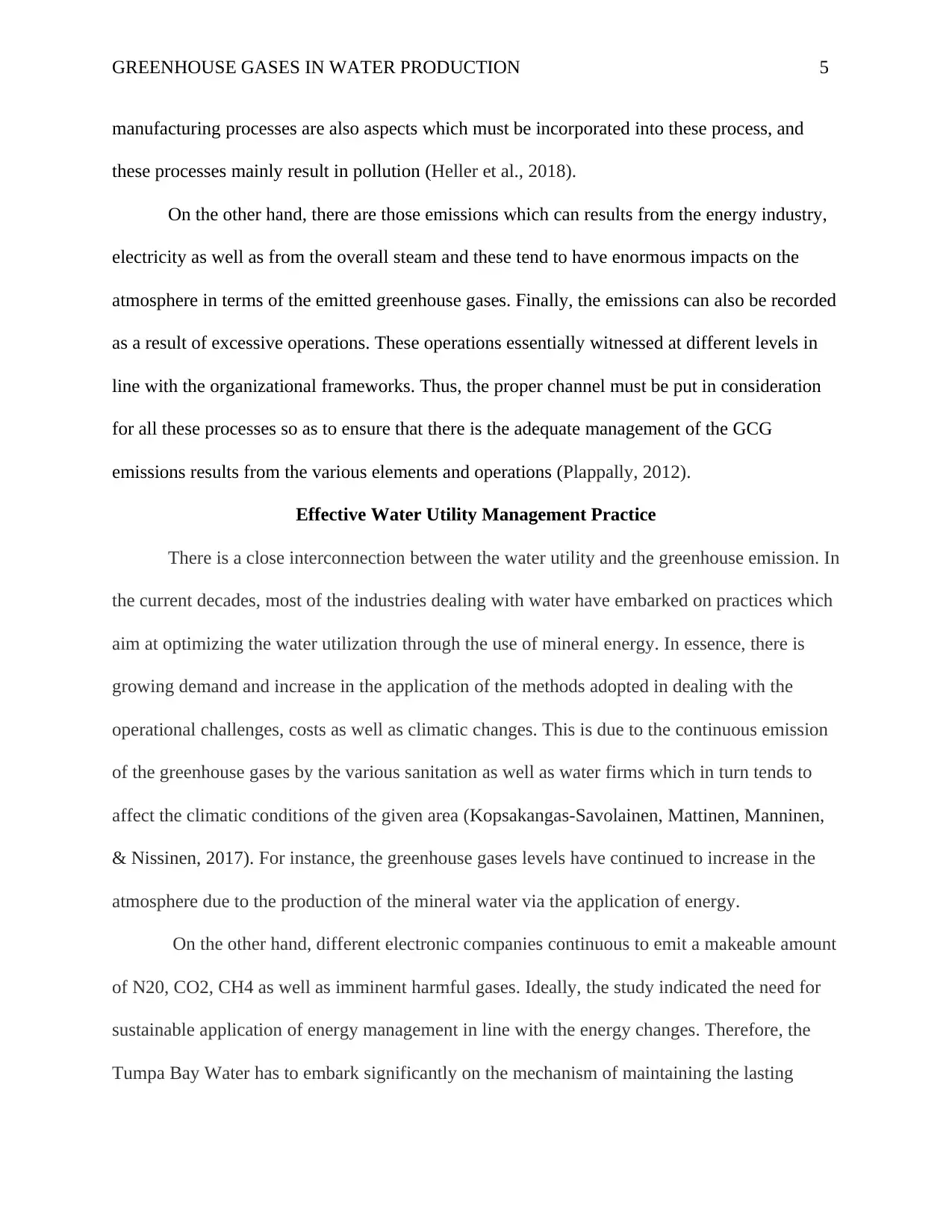
GREENHOUSE GASES IN WATER PRODUCTION 5
manufacturing processes are also aspects which must be incorporated into these process, and
these processes mainly result in pollution (Heller et al., 2018).
On the other hand, there are those emissions which can results from the energy industry,
electricity as well as from the overall steam and these tend to have enormous impacts on the
atmosphere in terms of the emitted greenhouse gases. Finally, the emissions can also be recorded
as a result of excessive operations. These operations essentially witnessed at different levels in
line with the organizational frameworks. Thus, the proper channel must be put in consideration
for all these processes so as to ensure that there is the adequate management of the GCG
emissions results from the various elements and operations (Plappally, 2012).
Effective Water Utility Management Practice
There is a close interconnection between the water utility and the greenhouse emission. In
the current decades, most of the industries dealing with water have embarked on practices which
aim at optimizing the water utilization through the use of mineral energy. In essence, there is
growing demand and increase in the application of the methods adopted in dealing with the
operational challenges, costs as well as climatic changes. This is due to the continuous emission
of the greenhouse gases by the various sanitation as well as water firms which in turn tends to
affect the climatic conditions of the given area (Kopsakangas-Savolainen, Mattinen, Manninen,
& Nissinen, 2017). For instance, the greenhouse gases levels have continued to increase in the
atmosphere due to the production of the mineral water via the application of energy.
On the other hand, different electronic companies continuous to emit a makeable amount
of N20, CO2, CH4 as well as imminent harmful gases. Ideally, the study indicated the need for
sustainable application of energy management in line with the energy changes. Therefore, the
Tumpa Bay Water has to embark significantly on the mechanism of maintaining the lasting
manufacturing processes are also aspects which must be incorporated into these process, and
these processes mainly result in pollution (Heller et al., 2018).
On the other hand, there are those emissions which can results from the energy industry,
electricity as well as from the overall steam and these tend to have enormous impacts on the
atmosphere in terms of the emitted greenhouse gases. Finally, the emissions can also be recorded
as a result of excessive operations. These operations essentially witnessed at different levels in
line with the organizational frameworks. Thus, the proper channel must be put in consideration
for all these processes so as to ensure that there is the adequate management of the GCG
emissions results from the various elements and operations (Plappally, 2012).
Effective Water Utility Management Practice
There is a close interconnection between the water utility and the greenhouse emission. In
the current decades, most of the industries dealing with water have embarked on practices which
aim at optimizing the water utilization through the use of mineral energy. In essence, there is
growing demand and increase in the application of the methods adopted in dealing with the
operational challenges, costs as well as climatic changes. This is due to the continuous emission
of the greenhouse gases by the various sanitation as well as water firms which in turn tends to
affect the climatic conditions of the given area (Kopsakangas-Savolainen, Mattinen, Manninen,
& Nissinen, 2017). For instance, the greenhouse gases levels have continued to increase in the
atmosphere due to the production of the mineral water via the application of energy.
On the other hand, different electronic companies continuous to emit a makeable amount
of N20, CO2, CH4 as well as imminent harmful gases. Ideally, the study indicated the need for
sustainable application of energy management in line with the energy changes. Therefore, the
Tumpa Bay Water has to embark significantly on the mechanism of maintaining the lasting
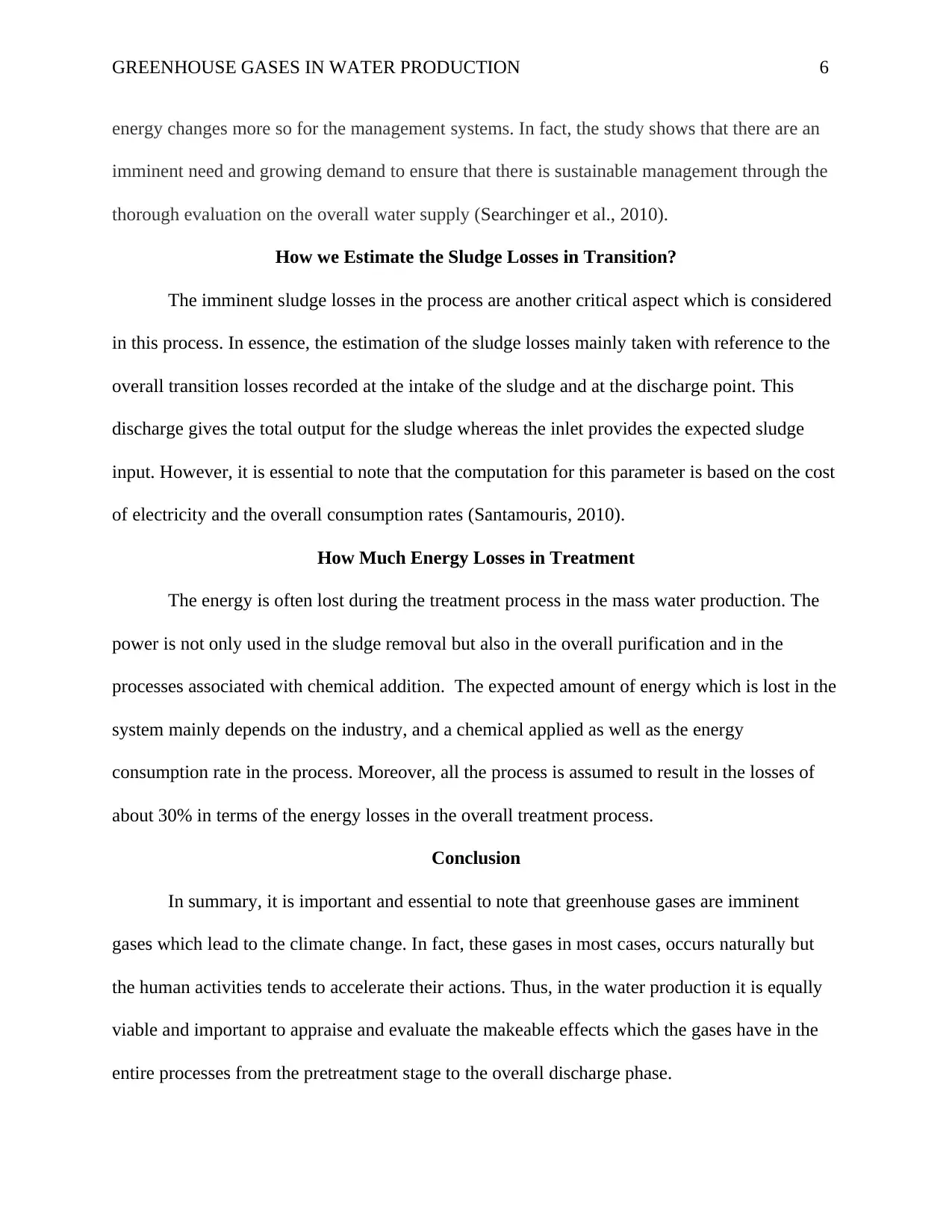
GREENHOUSE GASES IN WATER PRODUCTION 6
energy changes more so for the management systems. In fact, the study shows that there are an
imminent need and growing demand to ensure that there is sustainable management through the
thorough evaluation on the overall water supply (Searchinger et al., 2010).
How we Estimate the Sludge Losses in Transition?
The imminent sludge losses in the process are another critical aspect which is considered
in this process. In essence, the estimation of the sludge losses mainly taken with reference to the
overall transition losses recorded at the intake of the sludge and at the discharge point. This
discharge gives the total output for the sludge whereas the inlet provides the expected sludge
input. However, it is essential to note that the computation for this parameter is based on the cost
of electricity and the overall consumption rates (Santamouris, 2010).
How Much Energy Losses in Treatment
The energy is often lost during the treatment process in the mass water production. The
power is not only used in the sludge removal but also in the overall purification and in the
processes associated with chemical addition. The expected amount of energy which is lost in the
system mainly depends on the industry, and a chemical applied as well as the energy
consumption rate in the process. Moreover, all the process is assumed to result in the losses of
about 30% in terms of the energy losses in the overall treatment process.
Conclusion
In summary, it is important and essential to note that greenhouse gases are imminent
gases which lead to the climate change. In fact, these gases in most cases, occurs naturally but
the human activities tends to accelerate their actions. Thus, in the water production it is equally
viable and important to appraise and evaluate the makeable effects which the gases have in the
entire processes from the pretreatment stage to the overall discharge phase.
energy changes more so for the management systems. In fact, the study shows that there are an
imminent need and growing demand to ensure that there is sustainable management through the
thorough evaluation on the overall water supply (Searchinger et al., 2010).
How we Estimate the Sludge Losses in Transition?
The imminent sludge losses in the process are another critical aspect which is considered
in this process. In essence, the estimation of the sludge losses mainly taken with reference to the
overall transition losses recorded at the intake of the sludge and at the discharge point. This
discharge gives the total output for the sludge whereas the inlet provides the expected sludge
input. However, it is essential to note that the computation for this parameter is based on the cost
of electricity and the overall consumption rates (Santamouris, 2010).
How Much Energy Losses in Treatment
The energy is often lost during the treatment process in the mass water production. The
power is not only used in the sludge removal but also in the overall purification and in the
processes associated with chemical addition. The expected amount of energy which is lost in the
system mainly depends on the industry, and a chemical applied as well as the energy
consumption rate in the process. Moreover, all the process is assumed to result in the losses of
about 30% in terms of the energy losses in the overall treatment process.
Conclusion
In summary, it is important and essential to note that greenhouse gases are imminent
gases which lead to the climate change. In fact, these gases in most cases, occurs naturally but
the human activities tends to accelerate their actions. Thus, in the water production it is equally
viable and important to appraise and evaluate the makeable effects which the gases have in the
entire processes from the pretreatment stage to the overall discharge phase.
⊘ This is a preview!⊘
Do you want full access?
Subscribe today to unlock all pages.

Trusted by 1+ million students worldwide
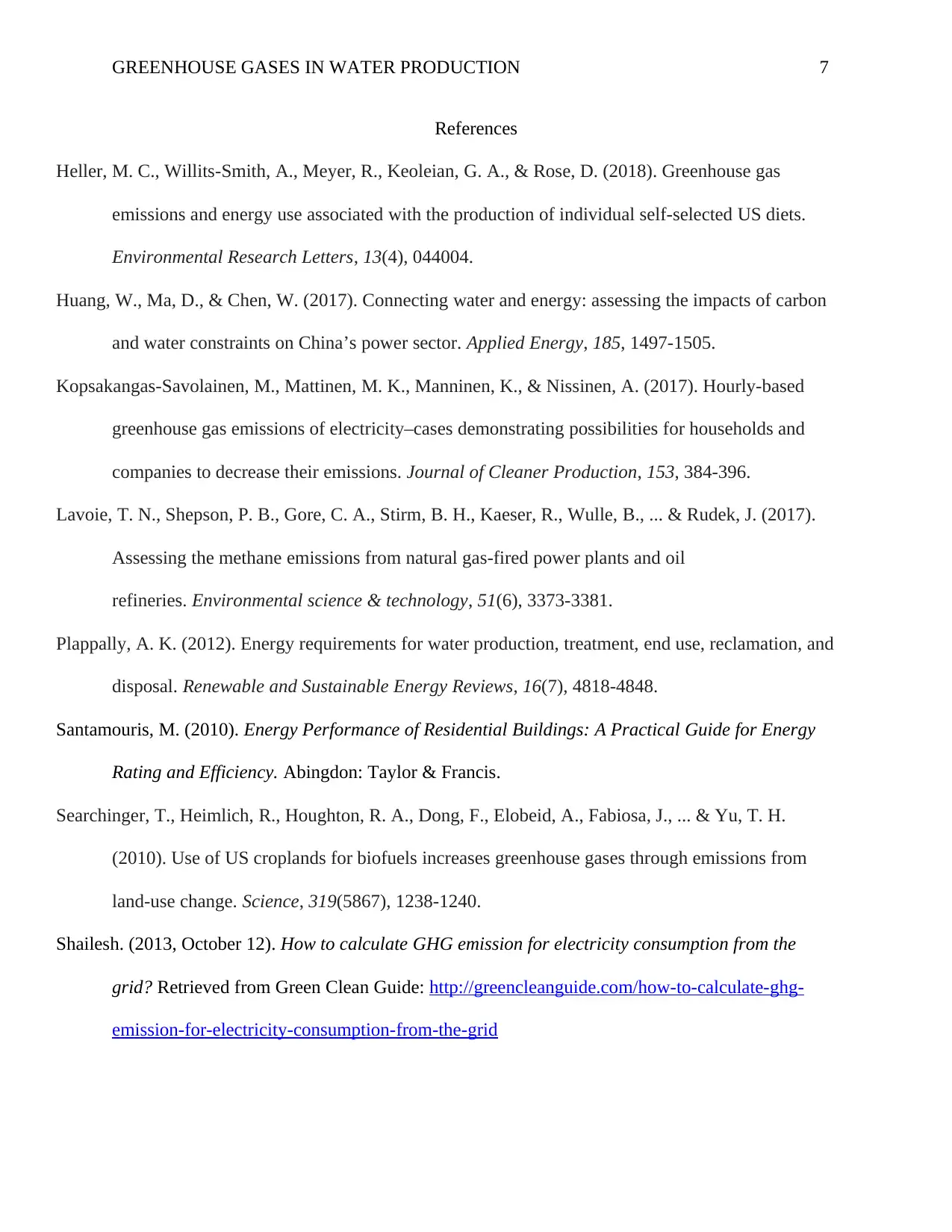
GREENHOUSE GASES IN WATER PRODUCTION 7
References
Heller, M. C., Willits-Smith, A., Meyer, R., Keoleian, G. A., & Rose, D. (2018). Greenhouse gas
emissions and energy use associated with the production of individual self-selected US diets.
Environmental Research Letters, 13(4), 044004.
Huang, W., Ma, D., & Chen, W. (2017). Connecting water and energy: assessing the impacts of carbon
and water constraints on China’s power sector. Applied Energy, 185, 1497-1505.
Kopsakangas-Savolainen, M., Mattinen, M. K., Manninen, K., & Nissinen, A. (2017). Hourly-based
greenhouse gas emissions of electricity–cases demonstrating possibilities for households and
companies to decrease their emissions. Journal of Cleaner Production, 153, 384-396.
Lavoie, T. N., Shepson, P. B., Gore, C. A., Stirm, B. H., Kaeser, R., Wulle, B., ... & Rudek, J. (2017).
Assessing the methane emissions from natural gas-fired power plants and oil
refineries. Environmental science & technology, 51(6), 3373-3381.
Plappally, A. K. (2012). Energy requirements for water production, treatment, end use, reclamation, and
disposal. Renewable and Sustainable Energy Reviews, 16(7), 4818-4848.
Santamouris, M. (2010). Energy Performance of Residential Buildings: A Practical Guide for Energy
Rating and Efficiency. Abingdon: Taylor & Francis.
Searchinger, T., Heimlich, R., Houghton, R. A., Dong, F., Elobeid, A., Fabiosa, J., ... & Yu, T. H.
(2010). Use of US croplands for biofuels increases greenhouse gases through emissions from
land-use change. Science, 319(5867), 1238-1240.
Shailesh. (2013, October 12). How to calculate GHG emission for electricity consumption from the
grid? Retrieved from Green Clean Guide: http://greencleanguide.com/how-to-calculate-ghg-
emission-for-electricity-consumption-from-the-grid
References
Heller, M. C., Willits-Smith, A., Meyer, R., Keoleian, G. A., & Rose, D. (2018). Greenhouse gas
emissions and energy use associated with the production of individual self-selected US diets.
Environmental Research Letters, 13(4), 044004.
Huang, W., Ma, D., & Chen, W. (2017). Connecting water and energy: assessing the impacts of carbon
and water constraints on China’s power sector. Applied Energy, 185, 1497-1505.
Kopsakangas-Savolainen, M., Mattinen, M. K., Manninen, K., & Nissinen, A. (2017). Hourly-based
greenhouse gas emissions of electricity–cases demonstrating possibilities for households and
companies to decrease their emissions. Journal of Cleaner Production, 153, 384-396.
Lavoie, T. N., Shepson, P. B., Gore, C. A., Stirm, B. H., Kaeser, R., Wulle, B., ... & Rudek, J. (2017).
Assessing the methane emissions from natural gas-fired power plants and oil
refineries. Environmental science & technology, 51(6), 3373-3381.
Plappally, A. K. (2012). Energy requirements for water production, treatment, end use, reclamation, and
disposal. Renewable and Sustainable Energy Reviews, 16(7), 4818-4848.
Santamouris, M. (2010). Energy Performance of Residential Buildings: A Practical Guide for Energy
Rating and Efficiency. Abingdon: Taylor & Francis.
Searchinger, T., Heimlich, R., Houghton, R. A., Dong, F., Elobeid, A., Fabiosa, J., ... & Yu, T. H.
(2010). Use of US croplands for biofuels increases greenhouse gases through emissions from
land-use change. Science, 319(5867), 1238-1240.
Shailesh. (2013, October 12). How to calculate GHG emission for electricity consumption from the
grid? Retrieved from Green Clean Guide: http://greencleanguide.com/how-to-calculate-ghg-
emission-for-electricity-consumption-from-the-grid
Paraphrase This Document
Need a fresh take? Get an instant paraphrase of this document with our AI Paraphraser
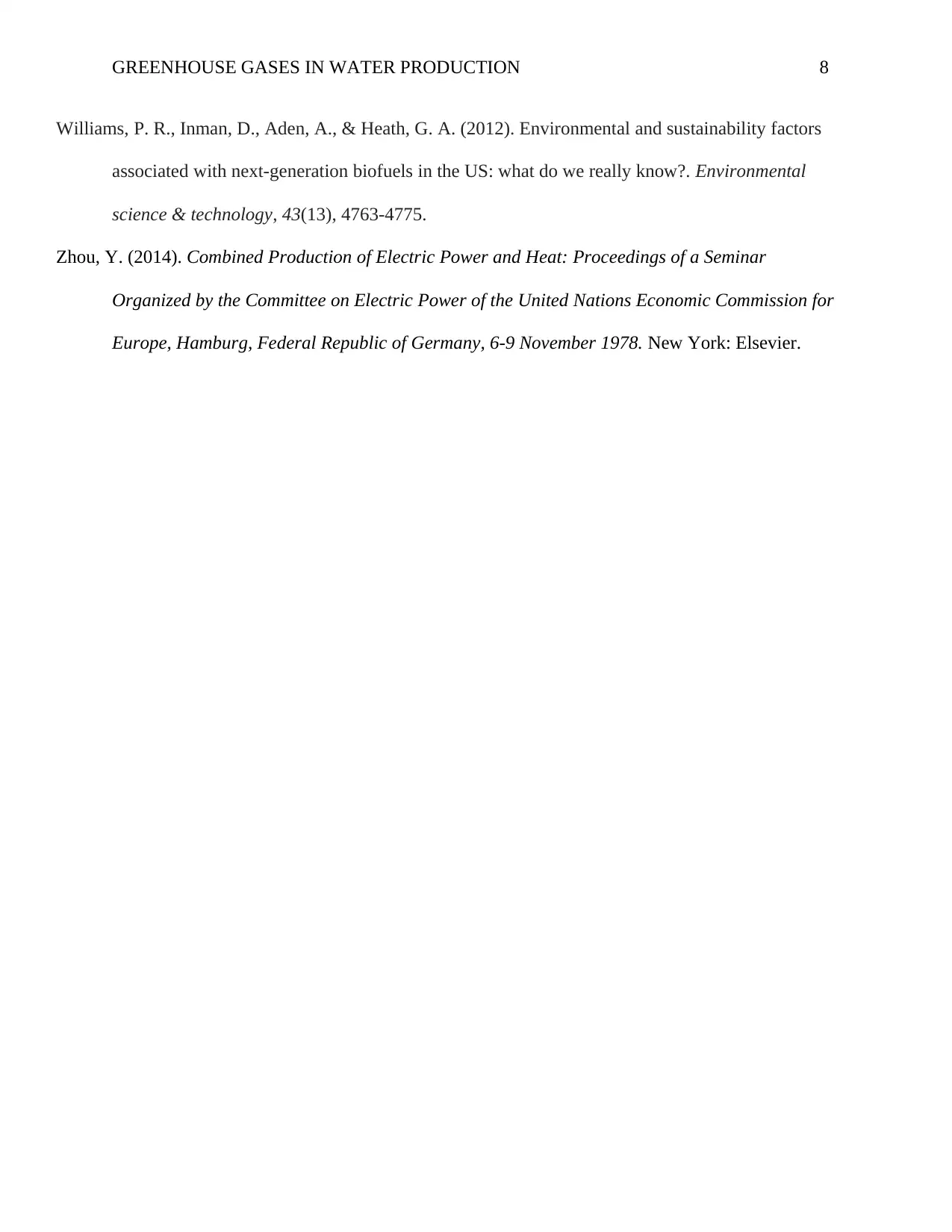
GREENHOUSE GASES IN WATER PRODUCTION 8
Williams, P. R., Inman, D., Aden, A., & Heath, G. A. (2012). Environmental and sustainability factors
associated with next-generation biofuels in the US: what do we really know?. Environmental
science & technology, 43(13), 4763-4775.
Zhou, Y. (2014). Combined Production of Electric Power and Heat: Proceedings of a Seminar
Organized by the Committee on Electric Power of the United Nations Economic Commission for
Europe, Hamburg, Federal Republic of Germany, 6-9 November 1978. New York: Elsevier.
Williams, P. R., Inman, D., Aden, A., & Heath, G. A. (2012). Environmental and sustainability factors
associated with next-generation biofuels in the US: what do we really know?. Environmental
science & technology, 43(13), 4763-4775.
Zhou, Y. (2014). Combined Production of Electric Power and Heat: Proceedings of a Seminar
Organized by the Committee on Electric Power of the United Nations Economic Commission for
Europe, Hamburg, Federal Republic of Germany, 6-9 November 1978. New York: Elsevier.
1 out of 8
Related Documents
Your All-in-One AI-Powered Toolkit for Academic Success.
+13062052269
info@desklib.com
Available 24*7 on WhatsApp / Email
![[object Object]](/_next/static/media/star-bottom.7253800d.svg)
Unlock your academic potential
Copyright © 2020–2025 A2Z Services. All Rights Reserved. Developed and managed by ZUCOL.





